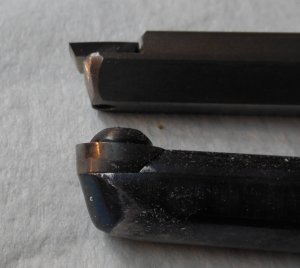Really didn't like the chippy acrylics, but a cheap faceshield from HFT solved the major problem for me (chips flying at my face).
A good firm grip is good advice ....
Move slowly, take small cuts .... also great advice ...
Ultra-sharp tools is a must, for acrylics.
Using your chisels correctly ..... ahh, now there's a subject that many will expound upon in great detail and discourse and argue with each other over which of them is more right than the other, all while saying that, "your method may work OK for you, but mine is better, so you should try it and see!"
But starting with the basics is usually also a good way to go.
Generally, you will want to keep a good firm grip so that your chisel is held tight against the tool rest, with the rest as close to the work as is comfortable to you (in order to eliminate chatter and vibration). You will want to move the chisel SLOWLY into the work piece, making contact first NOT WITH THE EDGE OF YOUR CUTTING TOOL, but with THE BEVEL OF YOUR CUTTING TOOL.
As the bevel rubs against the work piece, you use your off-hand (that is holding the back of your tool handle for leverage) to raise the back of the chisel and drop the edge down just to where the tool starts cutting. This is the most effective cutting angle you can maintain!
You have to practice this sequence of events til they become ingrained in you .... firm contact with the toolrest, rub bevel, lift back of tool til you start cutting.
This is the normal standard with all roughing gouges, bowl gouges, scrapers, and skews (though with the skew it's more of a slight rocking motion to get the edge of that chisel exactly where you want it .... skews are slightly more advanced than the basic chisels). Once you have mastered this technique, I suggest you try out everybody else's methods, and see what really works for you and you alone.
Keep in mind that certain specialty tools do not follow these steps, and many tools (the skew especially included) can and are used in different ways to perform different tasks. Learning the hows and whys and where to use a certain tool and technique to perform specific tasks are the stepping stones to becoming a master craftsman.
I just wish I was at least HALFWAY there.


